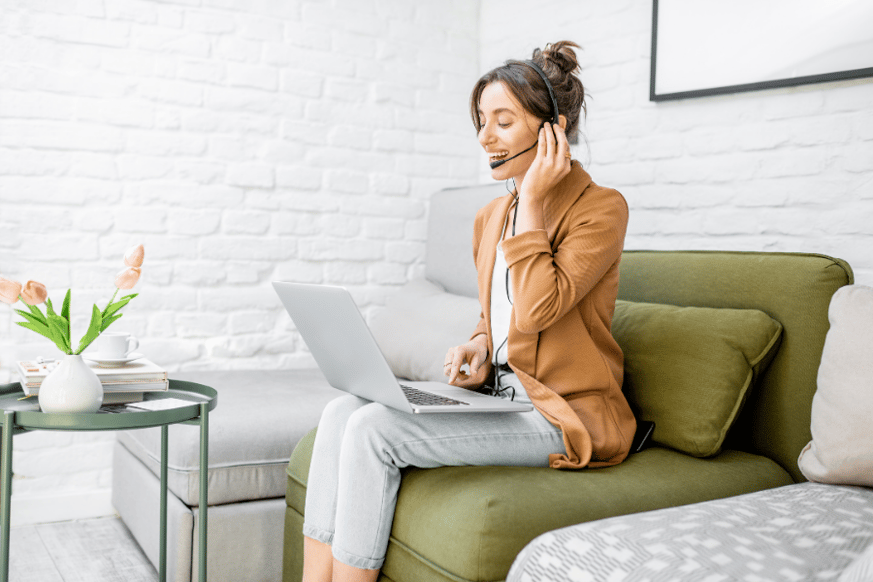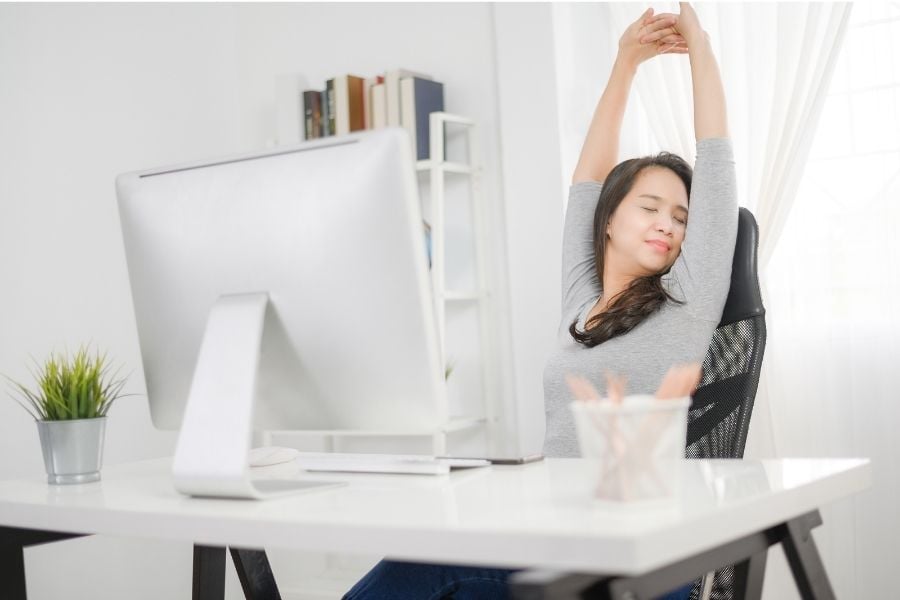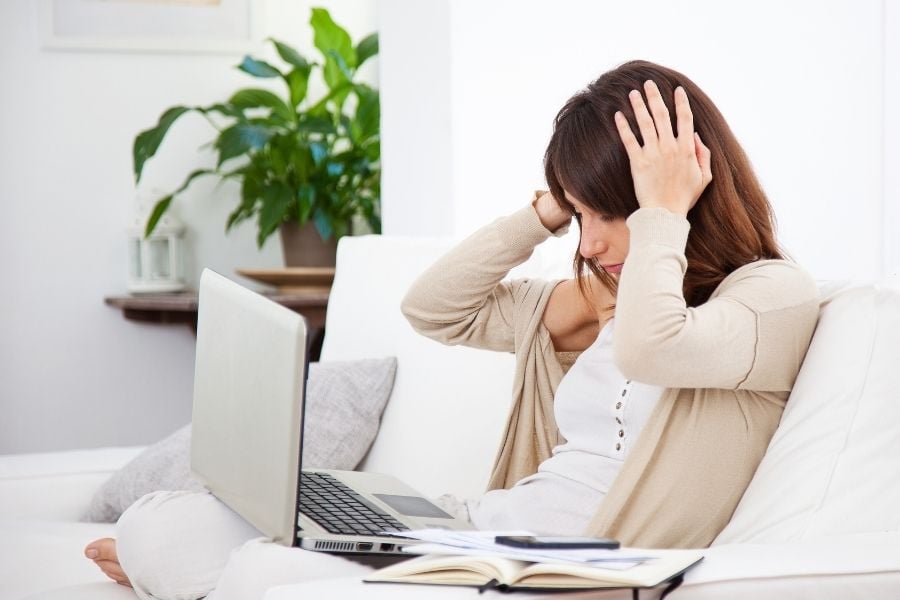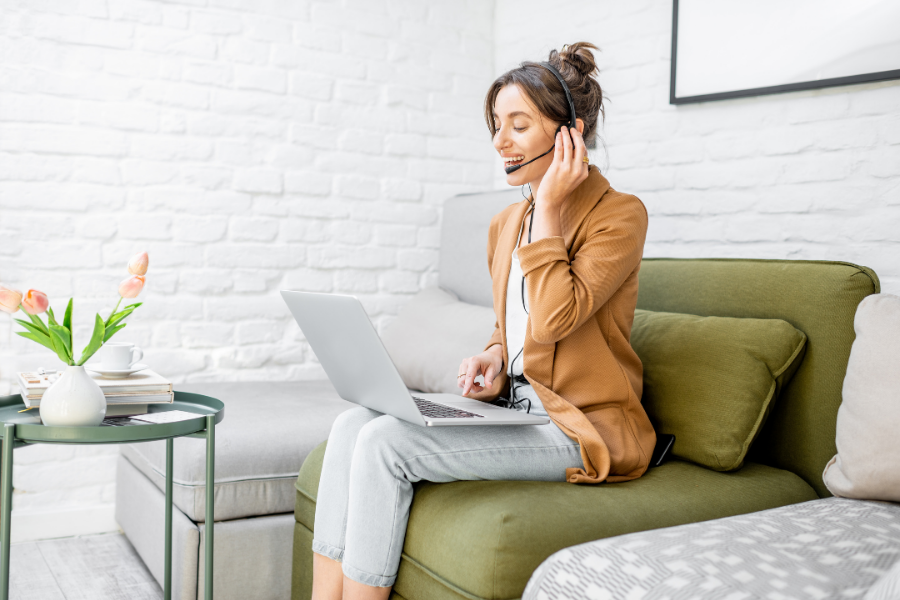For many people, the days of commuting to the office and meeting face-to-face with colleagues have come to a halt. As current events unfold, life as we know it is changing in ways we never could have never predicted. Not only does this challenge us to become more adaptable, but it also provides us with new opportunities to collaborate and work together.

Working away from the office can bring notable benefits like more productivity and fewer distractions for some. But for others, juggling your job with other responsibilities in the place you call home can be a challenge.
It might be tempting to crawl back into bed on Monday morning and check emails, but the way you work from home can have big implications on your overall health well-being. We put together this guide to encourage safe, healthy and effective work styles during these unprecedented times–all with the help of expert members from our team at HealthOne.
Start With Your Setup
Bringing your laptop to bed and working from the cozy comfort of your sheets might feel good in the moment, but according to Megan McInroy, Rehab Director & Physiotherapist at HealthOne, that temporary comfort can lead to discomfort and posture issues down the road.
Our bodies aren’t meant to be stationary throughout the day, which is why your technology setup at home is important to consider.
One of Megan’s first suggestions is switching from a laptop or tablet to a desktop monitor. Although portable devices are lighter and more convenient, they can take a hefty toll on your body due to the way they’re designed.
The angle of a laptop screen, for example, can cause you to hunch over and develop poor posture because the screen is not at eye level. In comparison, a desktop allows you to look directly at the screen, which promotes a straighter spine and prevents twisting and turning of the neck. If you experience pain from poor posture, physiotherapy treatment can help you.
If switching to a desktop isn’t an option for you, aim to have your laptop an arm’s length away from your eyes. Try to have the top of the screen slightly below eye level, and at an angle that reduces glare. There are also a variety of laptop stands you can purchase so your device promotes better alignment and has a lower risk of creating strain in the body.
Try Ergonomic Products
Megan’s second tip for taking care of your physical body is to explore the world of ergonomic products. There are plenty of options available that can make working from home a more comfortable experience–and finding the right ones for you can even be fun!
For starters, the seat you choose to work in is an important decision. Sitting on a dining room chair might feel like an easy or “good enough” choice, but investing in products that support your spine properly will do wonders in the long run. If you can, consider swapping to an ergonomic desk chair with an adjustable height and armrests.
Megan also recommends using a lumbar pillow to improve your posture, since it provides extra cushioning for your back. These pillows are a great option for people who sit at a desk all day–and who can say no to some extra comfort? Obusforme makes excellent quality lumbar pillows, however, there are plenty of options available for every person’s preferences and budget.
If a lot of your day is spent typing, a wrist rest can also be a great ergonomic choice for your working from home setup. The supportive padding can help reduce the bending of your wrists and promote a neutral posture.
Get Moving

Just because your device is portable, doesn’t mean your work setup should be. Megan emphasizes the importance of moving your body each day, but she also indicates that going from the kitchen to the couch with your laptop doesn’t quite cut it.
The key is to incorporate movement away from your workstation. Start by making sure you designate a specific area of the house for doing work (ideally with optimized devices and ergonomic products!). Then, commit to using that space for work and work only. This will help you create better boundaries between “work time” and “break time”. We've also covered more tips for achieving work life balance in this blog post.
During these breaks, you can move your body by taking a 5-minute walk around the block, playing with your dog in the backyard, or walking to the kitchen to make a cup of coffee. This will promote healthier functionality in the body and reduce your risk of developing pain. It also helps prevent the sedentary lifestyle so many of us fall into when staying at home.
Megan also recommends finding time to stretch throughout the day, whether you only have 2 minutes or 10. There are lots of easy, gentle stretches you can incorporate in your day–and you can even do them at your desk! Check out this video for a quick 6-minute sequence to try at home.

Give Your Eyes a Break
Taking care of your body and posture is essential for working from home, but an equally important factor is your eye health. For Andrew Liang, our Optometry Director & Optometrist, optical health is what he knows best. He’s a firm believer that eye health should be prioritized, especially in this digital age when there’s more stress on our eyes than ever before.
Our eyes have to exert effort when focusing on near objects, such as a computer screen. Like all muscles, the eyes can also become fatigued if overused. There is plenty of research to support the link between screen use and uncomfortable symptoms, like dry eyes. This is why Andrew’s first tip is to give your hard-working eyes a break.
Specifically, he recommends that you look at distant objects for 10 minutes for every 30-40 minutes spent in front of a screen. This can be out a window or down a hallway, for example. By giving your eyes a much-needed break, you can work more efficiently during the periods you are looking at a screen.
Try Forced Blinks
During the breaks you take to rest your eyes, Andrew also recommends trying a forced blink about 10-15 times. The reason is that blinking is a necessary factor in preventing dry eyes.
Symptoms of dry eyes can include stinging, burning, eye redness and watery eyes among others–and it’s more common than you might think. Experiencing these uncomfortable symptoms can get in the way of work, not to mention other responsibilities or tasks that bring you joy. It’s also more common in people who work from home because studies suggest our blinking decreases in both quality and quantity in front of a screen.
So, even if it feels a little silly, take a proactive step and incorporate forced blinks into your breaks from work. Preventing the onset of dry eye symptoms can reduce the likelihood of eye issues interfering with work later on in life. Learn more about dry eve treatment and prevention in this blog post.
Reduce Blue Light
Have you ever wondered why your phone has a setting called “night mode”? This is because it uses software to cut down blue light outputs from your LED screen. If you’re guilty of staying up late to finish work projects or checking your email on your phone, this can have a big impact on your eye health. According to Andrew, blue lights have been shown to disrupt sleep patterns, not to mention potentially harm your retina with overexposure.
Because of this, he suggests avoiding screens as much as possible around an hour and a half before bed. If you’re used to using devices until the very moment you fall asleep, try cutting back a bit of time each week and work your way up.

Choose Calming Colours
Colours can have an incredible impact on the brain. In fact, researchers have spent years studying the link between colour and our moods and behaviour.
When it comes to picking shades for your workspace, it’s essential to determine how you want to feel during work. It’s also worth reflecting on the type of work you do. Key shades worth knowing about based on colour psychology research include:
- Light blue, which can promote productivity, focus, clear thoughts, and soothe the mind.
- Green, which can promote balance and a feeling of calm, and is easy on the eyes.
- Yellow, which can promote creativity, happiness, and positive feelings.
- Red, which can increase blood flow and heart rate. It is best suited if your job requires high productivity and energy levels, but not as effective for a calming effect.
For some people, a large-scale change like repainting your office might be feasible. Adding a blue accent wall to your office might be exactly what you need to feel more productive and clearer-headed in your workspace.
But for others, even small ways to incorporate colour can promote a healthier working from home experience. A couple of plants can bring pops of green into your space without having to make a big commitment. Use the power of colour psychology as you see fit to compliment your workspace and reduce your levels of stress.

Manage Stress
Most jobs are challenging enough before the added distractions of working from home. Submitting a project before a tight deadline is a lot more stressful if the doorbell is ringing, there’s construction outside, and your dog is barking non-stop in the backyard.
Managing stress is the last, and perhaps the most important, component of HealthOne’s Healthy Home Office Set-up Guide. We understand how challenging it can be to readjust your routines and lifestyles, but small changes can have big results on your overall mental well-being.
Meditation is a great tool for people of all ages to ease anxiety and quiet the mind. There are many great meditation apps, like Calm, that are perfect for beginners. You can also access free guided meditations and soothing music online. We have more tips for starting your meditation practice on our blog.
You can also incorporate different products at your workstation for quick ways to manage your stress. An inexpensive stress ball can be a great option for an immediate way to get your feelings out (bonus points if it’s a soothing colour, like blue or green!). Fidget toys or an adult colouring book can also be a great way to keep your hands–and mind–at ease during anxious times.
The key is to identify when you’re feeling overwhelmed, and seek small ways to make your life a little easier. Managing stress, along with the other components of our Healthy Home Office Set-up Guide, will ensure you bring your healthiest, most productive self to “work” every day.
We hope our guide encourages you to take care of your body and mind during new routines, and find ease in working from home.

